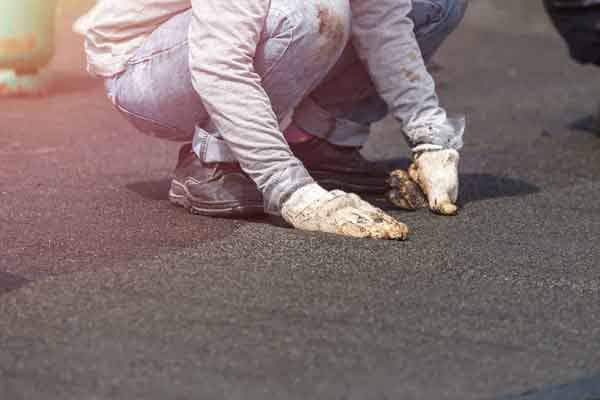Bituminous roofing technology
Bituminous roofing technology involves several stages of work. To begin with, a clean, dry and level roof base is required. The coating is laid from one edge, using hot bitumen or special glue to press and ensure tightness. It is important to place the overlaps correctly and ensure that all seams are carefully sealed. When laying, it is necessary to pay attention to the avoidance of air pockets and to ensure a continuous waterproof surface.
A bituminous roof is a combination of asphalt and rubber, designed for a flexible and durable roof that can withstand cold and hot conditions. It offers superior protection against UV rays, heat and moisture, making it an ideal choice for areas with extreme climates.
Bituminous roofing has many advantages that make it a popular choice for various types of buildings. First of all, it is waterproof, providing excellent waterproofing and protection against rain and snow. Due to its elasticity, the bituminous coating withstands temperature fluctuations well, without losing its properties during cold or heat. In addition, bituminous coatings are durable and long-lasting, capable of serving for decades with minimal maintenance. They also offer good sound insulation, reducing noise from the outside. Installation is relatively simple and economical, and the wide selection of colors and textures allows for easy adaptation to various architectural styles.
Requirements for laying bituminous roofing
- Smooth surface: The surface of the roof must be smooth, without depressions or bumps, to ensure the correct fit of the coating.
- Dryness: It is necessary that the roof is completely dry when laying the bituminous coating, because moisture can affect the quality of the bonding and cause cracks.
- Strength: The base material must be strong and sturdy enough to support the weight and hold the coating in place.
- Protective layer: Before laying the bituminous roof covering, check whether there is a protective layer that provides additional sound and heat insulation.
- Resistance to conditions: It is necessary to take into account the local climatic conditions and choose a bituminous roof covering that meets the requirements of the local environment, including resistance to wind, rain and snow.
4 steps of bituminous
roofing technologies
Bituminous roofing is a popular choice due to its durability and longevity. This technology includes several essential steps to ensure a high-quality and long-lasting coating.
First of all, it is necessary to prepare the base of the roof. It can be wooden boards, plywood or OSB boards. The surface must be clean, smooth and dry, without any irregularities or bumps. Any defects must be removed or leveled to ensure good adhesion of the bituminous coating.
The second step is laying the waterproofing material. As a rule, bituminous mastic or primer is used, which increases the adhesion of the bituminous coating to the base. The primer must be applied evenly, following the manufacturer's recommendations.
The third stage is the laying of bituminous sheets or rolls. The rolls must be unrolled and cut to the required dimensions. When laying the first layer, it is necessary to ensure that it is straight and evenly covered. Sheets or rolls are laid from the bottom up, ensuring that each subsequent layer covers the previous one by a certain width, usually about 10 cm.
Joints are especially important, so they need to be well pressed and, if necessary, additionally treated with bituminous mastic. In order to make the joints stronger, it is recommended to use heat treatment, for example, heating the joints with special gas burners.
The fourth stage is the final inspection and finishing. Make sure that all connections are tight and there are no gaps or defects. If defects are found, they must be corrected immediately. After laying, the roof must be inspected and, if necessary, additionally protected from UV rays or mechanical damage using protective coatings or paints.
Actions after bituminous roofing
After laying bituminous roofing, several important steps must be taken to ensure the durability and tightness of the roof.
Carrying out these actions will help prevent premature wear of the bituminous coating.

Coating inspection
Immediately after laying, it should be inspected for visible damage, wrinkles, air bubbles or other defects. It is important to check all joints and seams, especially around roof edges, pipes, vents and other structural elements.
Installation of protective measures
The roof should be inspected regularly, especially after heavy rains, storms or snow. If damages are noticed in time, they can be fixed immediately, thus avoiding bigger problems, such as water leaks or damage to thermal insulation.
Installation of protective measures
Bituminous pavement can be damaged by mechanical factors, so it is recommended to install protective layers, such as shale or gravel aggregates, which protect the pavement from UV rays and physical damage.
Checking the water drainage system
Check downspouts, gutters and downspouts, which should be clean and free of blockages so that water can drain freely from the roof. Gutters and downspouts must be cleaned and damaged parts repaired.
In order to be guaranteed that the tiled roof will last for many years
Let us perform
pitched roof laying works
We provide a guarantee for all the work performed, and according to the agreement, we perform preventive maintenance work. We perform bituminous roof covering works according to certified, certified methodology. Works are performed with quality and time-tested materials.

